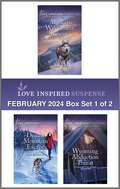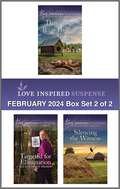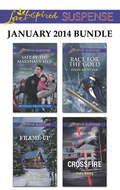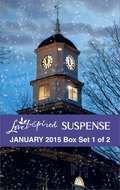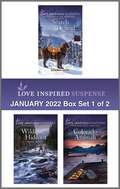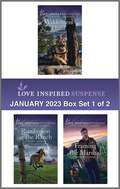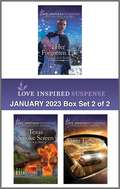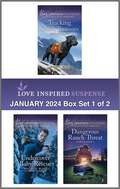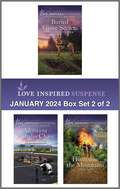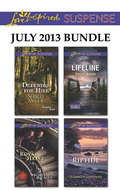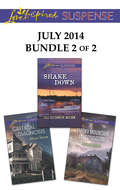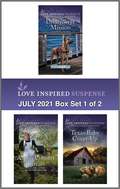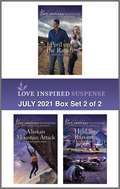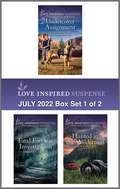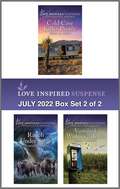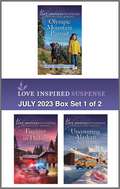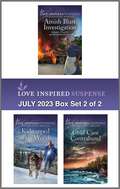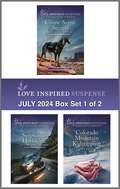- Table View
- List View
Love Inspired Suspense February 2024 - Box Set 1 of 2
by Sarah Varland Mary Alford Elisabeth ReesLove Inspired Suspense brings you three new titles! Enjoy these suspenseful romances of danger and faith.This box set includes: ALASKAN WILDERNESS RESCUE (A K-9 Search and Rescue novel)by Sarah VarlandA search for a missing hiker goes disastrously wrong when K-9 search and rescuer Elsie Montgomery and pilot Wyatt Chandler find themselves stranded on a remote Alaskan island. Only they&’re not alone. But is this a rescue mission…or a deadly trap?DEADLY MOUNTAIN ESCAPEby USA TODAY Bestselling Author Mary AlfordAttempting to find a kidnapped woman and expose a human trafficking ring nearly costs Deputy Charlotte Walker her life. But rancher Jonas Knowles saves her, and they work together to locate the others who have been abducted. Can they survive the onslaught of armed criminals and the perilous wilderness?WYOMING ABDUCTION THREATby Elisabeth ReesThere&’s only one thing stopping Sheriff Brent Fox from adopting his foster children: his adoption caseworker. But Carly Engelman has very good reasons for caution—all of which disappear when the children&’s ruthless biological father returns to abduct his kids…with revenge and murder on his mind.For more stories filled with danger and romance, look for Love Inspired Suspense February 2024 Box Set – 2 of 2
Love Inspired Suspense February 2024 - Box Set 2 of 2
by Jill Elizabeth Nelson Virginia Vaughan Laura ConawayLove Inspired Suspense brings you three new titles! Enjoy these suspenseful romances of danger and faith. This box set includes: DANGEROUS TEXAS HIDEOUT (A Cowboy Protectors novel)by Virginia VaughanWhen her daughter is the only witness able to identify a group of bank robbers, Penny Jackson knows their lives are in danger. Escaping to a small Texas town was supposed to be safe, but now they must rely on police chief Caleb Harmon to protect them from a killer bent on silencing them…TARGETED FOR ELIMINATION by Jill Elizabeth NelsonA morning jog becomes an exercise in terror when Detective Jen Blackwell is ambushed—until her ex-boyfriend Tyler Cade rescues her. Only someone is targeting them both, forcing Jen to team up with the park ranger to uncover the mystery behind the attacks…before it costs them their lives.SILENCING THE WITNESS by Laura ConawayAvery Sanford thought she was safe in witness protection…until her photo was leaked in the local paper. Now vengeful cartel members are on her tail and only former army commander Seth Brown can help her. But with assailants anticipating their every move, can Avery trust Seth to keep her alive long enough to testify?For more stories filled with danger and romance, look for Love Inspired Suspense February 2024 Box Set – 1 of 2
Love Inspired Suspense February 2025 - Box Set 1 of 2
by Rhonda Starnes Sharon Dunn Sarah VarlandLove Inspired Suspense brings you three new titles! Enjoy these suspenseful romances of danger and faith.This box set includes: K-9 ALASKAN DEFENSE (A K-9 Search and Rescue novel)by Sarah VarlandDiscovering a dead body in the woods turns into a fight for survival when Lily Peterson is attacked by an unknown assailant. Rescued by her retired police K-9, Timber, Lily calls the one man she trusts for help—her late fiancé&’s partner, former officer Travis Beckett. Only, the danger proves to be far from over when Lily&’s house goes up in flames. Someone wants her dead, and all clues lead to a connection to her departed fiancé&’s final case. Investigating the past is the only way to stay alive…but can they elude a killer neither expects?DEFENDING THE CHILDby USA Today bestselling author Sharon DunnAfter Marielle Coleman&’s foster son witnesses his mother&’s murder, he becomes a killer&’s next target. Escaping into a raging Montana snowstorm, Marielle and her little boy hide at a remote camp—and unexpectedly reunite with her ex-fiancé, Graham Flynn, an undercover DEA agent. Now Graham and Marielle must put aside their distrust to save the child from dangerous pursuers. But Graham&’s still hiding secrets from Marielle…ones that could tie them all to a conspiracy that will end their lives.COLD CASE MOUNTAIN MURDERby Rhonda StarnesWhen her seventeen-year-old daughter&’s murder is labeled a cold case, Jenna Hartley refuses to stop searching for answers—even as it puts her own life at risk. Her investigation podcast takes off, but the closer she comes to discovering what really happened to her only child, the deadlier the attempts on her life become. Retired Detective Sean Quinn warns her to leave the police work to the professionals, but he can&’t watch her risk her life alone. Now he has one goal: keep Jenna alive long enough to draw out the killer who&’s evaded them all…For more stories filled with danger and romance, look for Love Inspired Suspense February 2025 Box Set – 2 of 2
Love Inspired Suspense February 2025 - Box Set 2 of 2
by Susan Furlong Patricia Johns Carol J. PostLove Inspired Suspense brings you three new titles! Enjoy these suspenseful romances of danger and faith.This box set includes: UNCOVERING THE TRUTH (A Canine Defense novel)by Carol J. PostWhen Alyssa Anderson stumbles upon her ex-boyfriend&’s illegal art theft operation, she goes on the run—and narrowly escapes a drive-by shooting. With the help of her high school sweetheart, Spencer Cavanaugh, and his service dog, Apollo, Alyssa tries to stay one step ahead of her ex who will do anything to find her. When hit men are sent to her hometown, Alyssa&’s life is in more danger than ever before. Can Spencer and Apollo protect her from a crime ring more sinister than they ever imagined?GRAVE AMISH SECRETSby Patricia JohnsWhen her Amish grandfather&’s body is found, State Police Detective Penny Moore learns he didn&’t abandon his family fifty years ago—he was murdered. But the whole truth is still unknown, and after several vicious attacks on Penny and her partner, Detective Stewart Jones, it&’s clear someone will kill to keep their secrets buried. Unearthing community scandals and delving into Penny&’s traumatized family past bring them closer to each other—and a dangerous truth. But can they outwit a killer before they become the newest victims in this cold case?LETHAL WILDERNESS TRAPby Susan FurlongHunting a never-caught killer, Special Agent Nolan Shea learns of a new victim. But the body on Ava Burke&’s land puts her and her young daughter, Rose, in someone&’s lethal sights. With a trail of shocking clues pointing to her family&’s involvement, Ava starts to question everything she holds dear and is soon desperate to uncover the truth with Nolan. Step after step, they confront their fears. But will finally cornering a murderer out in the wilderness become a trap they can&’t escape?For more stories filled with danger and romance, look for Love Inspired Suspense February 2025 Box Set – 1 of 2
Love Inspired Suspense January 2014 Bundle
by Jill Elizabeth Nelson Shirlee Mccoy Dana Mentink Jodie BaileyLove Inspired Suspense brings you four new titles for one great price, available now! Enjoy these contemporary heart-pounding tales of suspense, romance, hope and faith. This Love Inspired Suspense bundle includes Safe by the Marshal's Side by Shirlee McCoy, Frame-Up by Jill Elizabeth Nelson, Race for the Gold by Dana Mentink and Crossfire by Jodie Bailey.Look for four new inspirational suspense stories every month from Love Inspired Suspense!
Love Inspired Suspense January 2015 - Box Set 1 of 2
by Hannah Alexander Carol J. Post Sara K. ParkerMore of the suspense you love -- now Love Inspired Suspense brings you six new titles, in two convenient bundles! Enjoy these contemporary heart-pounding tales of suspense, romance, hope and faith. This Love Inspired Suspense bundle includes Countdown to Danger by Hannah Alexander and Jill Elizabeth Nelson, Shattered Haven by Carol J. Post and Undercurrent by Sara Parker. Look for six new inspirational suspense stories every month from Love Inspired Suspense!
Love Inspired Suspense January 2015 - Box Set 2 of 2
by Laura Scott Elizabeth Goddard Heather WoodhavenIncludes: <P> Under the Lawman's Protection: As a skilled SWAT team negotiator, Isaac Morrison has defused many a crisis situation. But safeguarding Leah Nichols and her young son may be his most challenging mission yet. Leah's brother—his best friend Shane—has gone missing while working undercover. Now it's up to Isaac to protect mother and child from Shane's enemies. He doesn't know whom they can trust, but he's determined to catch the gunmen threatening their lives. Isaac knows he needs his best protection skills against their formidable adversary. Because he can't risk the consequences to the little family who has stealthily claimed his heart. <P> Buried: Fleeing to Alaska is the only option for Leah Marks after witnessing a murder. Afraid for her life, the legal investigator hopes a remote cabin will be a safe shelter. But the killer has tracked her to Mountain Cove. As he chases her into snow-packed Dead Falls Canyon, an avalanche buries them both. Saved by daring search and rescue specialist Cade Warren, Leah longs to tell him the truth. But how can she, without bringing even more danger into Cade's life? Especially when they discover the killer is very much alive and waiting to take them both down. <P> Calculated Risk: Accountant Victoria Hayes never would have thought discovering fraud in her office would put her life at risk. When her house catches fire, destroying the evidence she's collected, it seems the mastermind will do anything to keep Victoria from disclosing what she knows. Unsure what to do, she turns to her charming supervisor for help. But without much evidence, Jeff Tucker is reluctant to believe Victoria…until they both become suspects. Now they must work together to prove their innocence…and stay alive. With an unpredictable—and deadly—criminal after them, each step could be their last.
Love Inspired Suspense January 2022 - Box Set 1 of 2
by Hope White Heather Woodhaven Amity SteffenLove Inspired Suspense brings you three new titles! Enjoy these suspenseful romances of danger and faith. This box set includes: SEARCH AND DEFEND (A K-9 Search and Rescue novel)by Heather WoodhavenUndercover and tracking the assassin who killed his partner, FBI Special Agent Alex Driscoll accidentally pulls his partner&’s widow, Violet Sharp, and her search-and-rescue K-9, Teddy, into the case. Now with Violet&’s life on the line, they have to work together to bring an assassin to justice…and stay alive. WILDERNESS HIDEOUT (A Boulder Creek Ranch novel)By Hope WhiteRegaining consciousness in the Montana mountains with no memory of how she got there and an assailant after her, Dr. Brianna Wilkes must rely on a stranger for protection. But when hiding Brianna puts rancher Jacob Rush and his little girl in the crosshairs, they have to survive the wilderness and a killer. COLORADO AMBUSHBy Amity SteffenA mission to solve the mystery surrounding her sister&’s suspicious death sends Paige Bennett and her orphaned niece right into the path of ruthless gunman. And jumping into Deputy Jesse McGrath&’s boat is the only reason they escape with their lives. But can Jesse help Paige uncover the truth…before it&’s too late? For more stories filled with danger and romance, look for Love Inspired Suspense January 2022 Box Set – 1 of 2
Love Inspired Suspense January 2022 - Box Set 2 of 2
by Laura Scott Liz Shoaf Sami A. AbramsLove Inspired Suspense brings you three new titles! Enjoy these suspenseful romances of danger and faith. This box set includes: ROCKY MOUNTAIN STANDOFF (A Justice Seekers novel)by USA TODAY Bestselling Author Laura ScottSomeone will do anything to get Federal Judge Sidney Logan to throw a trial—even target her six-month-old foster daughter. And it&’s up to US Deputy Marshal Tanner Wilcox to keep Sidney and little Lilly safe. But with a possible mole in the courthouse, trusting anyone could prove lethal… TEXAS RANCH REFUGE By Liz ShoafAfter cowboy Mac Dolan and his dog, Barnie, stop an attempted abduction, Mac&’s surprised to learn the target is Liv Calloway—the woman the FBI contracted him to investigate. Letting Liv hide from her pursuers on his ranch provides Mac the perfect cover. But is she a murderer…or a witness being framed? BURIED COLD CASE SECRETSBy Sami A. AbramsSearching for her best friend&’s remains could help forensic anthropologist Melanie Hutton regain her memories of when they were both kidnapped—and put her right back in the killer&’s sights. But can Detective Jason Cooper set the past aside to help her solve his sister&’s murder…and shield Melanie from the same fate? For more stories filled with danger and romance, look for Love Inspired Suspense January 2022 Box Set – 2 of 2
Love Inspired Suspense January 2023 - Box Set 1 of 2
by Lenora Worth Lisa Phillips Sharee StoverLove Inspired Suspense brings you three new titles! Enjoy these suspenseful romances of danger and faith. This box set includes: WILDERNESS HUNT (A K-9 Search and Rescue story)by Lisa PhillipsK-9 Search and Rescue Officer Kelly Wayne is on the hunt for a downed plane carrying a federal witness. Mistaken for his brother, Ethan Harrigan has amnesia and he doesn&’t know why he&’s being hunted. Can he and Kelly find the answers before the criminals find them? RETRIBUTION AT THE RANCHby New York Times Bestselling Author Lenora WorthWhen PI Marco Landon accomplishes his assignment and finds reclusive heiress Amelia Garcia in a Texas cabin, someone starts shooting at them. Can they uncover the culprit trying to keep her from inheriting the Rio Rojo Ranch? FRAMING THE MARSHALby Sharee StoverUS Marshal Riker Kastell is being framed for the murder of a gang member, and his ex-girlfriend&’s DNA program is showing his image as the killer. But now the gang is after both of them, and they must stick together with his trusty K-9 to clear his name without becoming the next victims. For more stories filled with danger and romance, look for Love Inspired Suspense January 2023 Box Set – 2 of 2
Love Inspired Suspense January 2023 - Box Set 2 of 2
by Katy Lee Maggie K. Black Jessica R. PatchLove Inspired Suspense brings you three new titles! Enjoy these suspenseful romances of danger and faith. This box set includes: HER FORGOTTEN LIFEby USA TODAY Bestselling Author Maggie K. BlackSara Kilpatrick has no memory of her life before she ended up in an Amish farmhouse. When killers come after her, she must dig into her past and find a husband who thought she was dead and baby she doesn&’t remember. But with killers on their tail, will they live long enough for her to regain her memories? TEXAS SMOKE SCREEN (A Quantico Profilers thriller)by Jessica R. PatchAfter being badly burned in the house fire that killed her husband, FBI profiler Vera Gilmore&’s greatest fear is fire. But when her old boyfriend, homicide detective Brooks Brawley, asks her to profile a serial arsonist, she can&’t turn him down. And when the killer comes after, Brooks will stop at nothing to keep her safe. SANTA FE SETUPby Katy LeeAfter artist Luci Butler discovers someone has been hiding drugs in her paintings, she also finds ruthless killers are aiming to silence her. Only her brother&’s coworker Bard Holland is on her side as she must race to prove her innocence and stay alive. For more stories filled with danger and romance, look for Love Inspired Suspense January 2023 Box Set – 1 of 2
Love Inspired Suspense January 2024- Box Set 1 of 2
by Karen Kirst Maggie K. Black Lisa PhillipsLove Inspired Suspense brings you three new titles! Enjoy these suspenseful romances of danger and faith.This box set includes: TRACKING STOLEN TREASURES (A K-9 Search and Rescue novel)by Lisa PhillipsOn the trail of a vicious jewel-theft ring, FBI special agent Alena Sanchez is undercover at a medical conference when her prime suspect is kidnapped. Now she&’ll have to team up with K-9 officer Hank Miller to uncover how theft leads to cold-blooded murder.UNDERCOVER BABY RESCUEby USA TODAY Bestselling Author Maggie K. BlackTo save his stolen nephew from a dangerous trafficking organization, Officer Justin Leacock will have to go undercover as a married couple with his former fiancée, Detective Violet Jones. But finding the boy isn&’t enough—they must outwit the kidnappers on their tail and survive the ruthless icy wilderness, too…DANGEROUS RANCH THREATby Karen KirstWhen rancher Cassie West discovers that several murder victims bear a striking resemblance to her, it&’s clear there&’s a serial killer at large…and she&’s the next target. Can she and her temporary ranch hand Luke McCoy expose the killer before they exact vengeance?For more stories filled with danger and romance, look for Love Inspired Suspense January 2024 Box Set – 2 of 2
Love Inspired Suspense January 2024- Box Set 2 of 2
by Sharon Dunn Darlene L. Turner Addie EllisLove Inspired Suspense brings you three new titles! Enjoy these suspenseful romances of danger and faith.This box set includes: BURIED GRAVE SECRETS (A Crisis Rescue Team novel)by Darlene L. TurnerWhen forensic anthropologist Jordyn Miller is targeted for discovering an unmarked graveyard, she knows someone is determined to keep old secrets buried. Constable Colt Peters and his K-9 protector dog are called in to guard her life—but exposing a serial killer could be the last thing they do…MONTANA WITNESS CHASEby USA TODAY Bestselling Author Sharon DunnAfter testifying against her brother&’s murderer, Hope Miller is placed in witness protection—only to be attacked at her new safe house. With her identity compromised, it&’s up to US marshal Andrew Lewis to safeguard her. But stopping the crime ring could prove lethal for them both.HUNTED IN THE MOUNTAINSby Addie EllisPursued by assailants, a terrified child shows up at Julia Fay&’s door—and soon they&’re both running for their lives. Can Julia and former navy SEAL Troy Walker protect the boy against the unknown…when the truth could get them killed?For more stories filled with danger and romance, look for Love Inspired Suspense January 2024 Box Set – 1 of 2
Love Inspired Suspense January 2025 - Box Set 1 of 2
by Sami A. Abrams Laura Scott Shirley JumpLove Inspired Suspense brings you three new titles! Enjoy these suspenseful romances of danger and faith.This box set includes: TRACKING THE MISSING (A K-9 Search and Rescue novel)by Sami A. AbramsAfter surviving a vicious attack in the woods, Tori Campbell awakes to her worst nightmare—her son and his two friends are missing. She calls the one person she knows she can trust, her late husband&’s best friend, former DEA agent Michael Lane. Together with his search-and-rescue K-9, they must track the boys and figure out who took them—and why. Only, the Indiana wilderness is full of dangers beyond their abductor. Can Michael and Tori find the teens…even if it means falling into a sinister trap?TEXAS KIDNAPPING TARGET (A Texas Justice novel)by USA Today bestselling author Laura ScottWhen an intruder attempts to kidnap rancher Mari Lynch's four-year-old son, she fears it's connected to her ex-husband's criminal past. Texas Ranger Sam Hayward's arrival confirms her worst fears—her ex has escaped prison, making her a target. And when Sam finds a dead body on Mari&’s ranch, he suspects the incidents are related. Now Mari must depend on Sam to protect her little boy and catch the culprit. Will they be able to uncover the truth and stay alive, or will they become victims of a deadly conspiracy?COLD CASE DISAPPEARANCEby New York Times bestselling author Shirley JumpVlogger Annie Linscott is determined to investigate the unsolved disappearance of her friend Jenny. She travels to Crestville, Colorado, to make sure Jenny isn&’t forgotten as another statistic, with or without help from Sheriff Brady Johnson. Brady&’s faith—in himself, in justice, in God—has been tested lately, but he can&’t deny that something is off in the small town. When their digging catches the attention of sinister forces, Brady wants to protect Annie. But someone is determined to make sure this case remains cold…even if they have to kill for it.For more stories filled with danger and romance, look for Love Inspired Suspense January 2025 Box Set – 2 of 2
Love Inspired Suspense January 2025 - Box Set 2 of 2
by Beth Carpenter Dana Mentink Tina WheelerLove Inspired Suspense brings you three new titles! Enjoy these suspenseful romances of danger and faith.This box set includes: HUNTED ON THE TRAIL (A Security Hounds Investigations novel)by USA Today bestselling author Dana MentinkAmbushed by sudden gunfire, former cop Stephanie Wolfe realizes the tracking competition she entered with her bloodhound is a setup. An escaped fugitive has lured her into the remote wilderness to exact his deadly revenge. And her ex-boyfriend, bounty hunter Vance Silverton, has fallen into the fatal trap, too. Now cut off from civilization with only minimal supplies and their two dogs, the pair must depend on each other to survive. But with a treacherous storm approaching, it&’s not only a cold-blooded killer they&’ll have to escape.AMBUSH ON THE RANCH by Tina WheelerAfter running for her life through the forest, art gallery owner Janel Newman wakes up in the hospital with no memory of the past forty-eight hours. A car bomb and masked gunman make it clear she must&’ve seen something she shouldn&’t have. When she's forced to hide at deputy sheriff Zach Walker&’s family ranch along with her twin sister, secrets are uncovered, and a murderous conspiracy is revealed. With ruthless criminals dogging their every step, will Janel and Zach be able to thwart these villains&’ plan to silence Janel for good?ALASKAN WILDERNESS PERILby Beth CarpenterAntiques dealer Hannah Yates discovers an incredibly rare globe decorated with inlaid markings only to become the target of thieves who are growing increasingly more threatening. Someone wants this globe at any cost, and nowhere—even the remote Alaskan cabin of her former crush, Jace Angeles—is safe. On the run through the rugged wilderness, Hannah and Jace are forced to make one daring escape after another. But can they unlock the secrets of the globe…before they end up paying the ultimate price?For more stories filled with danger and romance, look for Love Inspired Suspense January 2025 Box Set – 1 of 2
Love Inspired Suspense July 2013 Bundle
by Shirlee Mccoy Rachelle Mccalla Christy Barritt Elizabeth GoddardLove Inspired Suspense brings you four new titles for one great price, available now for a limited time only from July 1 to July 31! Enjoy these contemporary heart-pounding tales of suspense, romance, hope and faith. This Love Inspired Suspense bundle includes Defender for Hire by Shirlee McCoy, Royal Heist by Rachelle McCalla, Lifeline by Christy Barritt, and Ripetide by Elizabeth Goddard.Look for four new inspirational suspense stories every month from Love Inspired Suspense!
Love Inspired Suspense July 2014 - Bundle 1 of 2: Protective Instincts Flood Zone Caught In The Crosshairs
by Shirlee Mccoy Dana Mentink Elisabeth ReesMore of the suspense you love-now Love Inspired Suspense brings you six new titles, in two convenient bundles! Enjoy these contemporary heart-pounding tales of suspense, romance, hope and faith. This Love Inspired Suspense bundle includes Protective Instincts by Shirlee McCoy, Flood Zone by Dana Mentink and Caught in the Crosshairs by Elisabeth Rees.Look for six new inspirational suspense stories every month from Love Inspired Suspense!
Love Inspired Suspense July 2014 - Bundle 2 of 2: Shake Down Critical Diagnosis Smoky Mountain Investigation
by Jill Elizabeth Nelson Alison Stone Annslee UrbanMore of the suspense you love-now Love Inspired Suspense brings you six new titles, in two convenient bundles!Enjoy these contemporary heart-pounding tales of suspense, romance, hope and faith. This Love Inspired Suspense bundle includes Shake Down by Jill Elizabeth Nelson, Critical Diagnosis by Alison Stone and Smoky Mountain Investigation by Annslee Urban.Look for six new inspirational suspense stories every month from Love Inspired Suspense!
Love Inspired Suspense July 2021 - Box Set 1 of 2
by Sharon Dunn Virginia Vaughan Dana R. LynnLove Inspired Suspense brings you three new titles! Enjoy these suspenseful romances of danger and faith. This box set includes:UNDERCOVER MISSION(An Alaska K-9 Unit novel)By USA TODAY Bestselling Author Sharon Dunn Undercover on a cruise ship with her K-9 partner, Alaska State Trooper Maya Rodriguez uses herself as bait for a murderer—and quickly becomes a target. Now as she and her dog work to stay one step ahead of a possible serial killer, security officer David Garrison is the only person she can trust. AMISH COUNTRY THREATS (An Amish Country Justice novel)By USA TODAY Bestselling Author Dana R. LynnWhile searching for proof that her brother&’s death was no accident, Lilah Schwartz is almost killed by a sniper. Hiding in Levi Burkholder&’s barn is all that keeps her alive. But can she and Levi uncover evidence her brother hid before she&’s the next to die for it? TEXAS BABY COVER-UP (A Cowboy Lawmen novel)By Virginia VaughanAs the new guardian of her murdered best friend&’s baby, social worker Kellyanne Avery will do anything to protect the little boy from someone intent on kidnapping him—even turn to her ex, Deputy Sheriff Zeke Tyler, for help. But as they hide on her family&’s ranch, will Zeke be able to shield them from harm? For more stories filled with danger and romance, look for Love Inspired Suspense July 2021 Box Set – 2 of 2
Love Inspired Suspense July 2021 - Box Set 2 of 2
by Lynette Eason Kathleen Tailer Sarah VarlandLove Inspired Suspense brings you three new titles at a great value, available now! Enjoy these suspenseful romances of danger and faith.This box set includes: PERIL ON THE RANCHBy Lynette EasonWhen someone tries to take an infant from her ranch, foster mother Isabelle Trent gets caught in the would-be abductor&’s deadly sights. With her ranch hand, Brian &“Mac&” McGee, at her side, can Isabelle protect the baby…and stay alive? ALASKAN MOUNTAIN ATTACKBy Sarah VarlandAfter being called to the scene of several suspicious accidents, search-and-rescue worker Piper McAdams is thrust into someone&’s lethal crosshairs. As threats on her life escalate, Officer Judah Wicks must figure out why someone wants her dead…before Piper pays the ultimate price. HELD FOR RANSOMBy Kathleen TailerTo free her sister who&’s being held hostage, Sophia Archer must prove a man's innocence before his criminal trial ends and the jury returns with a verdict. But time&’s running out as she works with her former friend, Noah Bradley, to discover the truth…and outwit someone who&’s willing to kill to silence them. For more stories filled with danger and romance, look for Love Inspired Suspense July 2021 Box Set – 1 of 2
Love Inspired Suspense July 2022 - Box Set 1 of 2
by Dana Mentink Kellie VanHorn Darlene L. TurnerLove Inspired Suspense brings you three new titles! Enjoy these suspenseful romances of danger and faith. This box set includes: UNDERCOVER ASSIGNMENT (A Rocky Mountain K-9 Unit novel)by USA TODAY bestselling author Dana MentinkInnkeeper and single father Sam Kavanaugh suspects someone is after his three-year-old son—so K-9 officer Daniella Vargas goes undercover as the little boy&’s nanny with her protection dog Zara. But can they solve the case and its mysterious connection to Sam&’s late wife before it&’s too late? FATAL FORENSIC INVESTIGATIONby Darlene L. TurnerWhile interviewing the Coastline Strangler&’s only surviving victim, forensic artist Scarlet Wells is attacked and left with amnesia. Now she&’s his next mark and has no choice but to work with constable Jace Allen to hunt down the killer before he strikes again… HUNTED IN THE WILDERNESSby Kellie VanHornFramed for murder and corporate espionage, future aerotech company CEO Haley Whitcombe flees in her plane with evidence that could clear her name—and is shot out of the sky. Now trapped in North Cascades National Park, she must work with park ranger Ezra Dalton to survive the wilderness and assassins. For more stories filled with danger and romance, look for Love Inspired Suspense July 2022 Box Set – 2 of 2
Love Inspired Suspense July 2022 - Box Set 2 of 2
by Jessica R. Patch Sarah Hamaker Sommer SmithLove Inspired Suspense brings you three new titles! Enjoy these suspenseful romances of danger and faith. This box set includes: COLD CASE KILLER PROFILER (A Quantico Profilers novel)by Jessica R. PatchSearching for the perfect morning landscape to paint leads forensic artist Brigitte Linsey straight to a dead body—and a narrow escape from the Sunrise Serial Killer still on the scene. Now that she&’s the killer&’s number one target, partnering with FBI Special Agent Duke Jericho might be her only chance at surviving… RANCH UNDER SIEGEby Sommer SmithBoston-based journalist Madison Burke has two goals when she heads to the Oklahoma ranch where her father works as a foreman: heal a family rift…and escape the person targeting her. But when danger follows her, can Madison rely on ranch owner and former Navy SEAL Briggs Thorpe to keep her alive? VANISHED WITHOUT A TRACEby Sarah HamakerAssistant District Attorney Henderson Parker just wants to follow the lead in Twin Oaks, Virginia to find his missing sister—not team up with podcaster Elle Updike. But after mysterious thugs make multiple attacks on his life, trusting Elle and her information might be his best opportunity to save them all… For more stories filled with danger and romance, look for Love Inspired Suspense July 2022 Box Set – 1 of 2
Love Inspired Suspense July 2023 - Box Set 1 of 2
by Jodie Bailey Elisabeth Rees Jenna NightComing soon! Love Inspired Suspense July 2023 - Box Set 1 of 2 by Jodie Bailey\Jenna Night\Elisabeth Rees will be available Jun 27, 2023.
Love Inspired Suspense July 2023 - Box Set 2 of 2
by Debby Giusti Jaycee Bullard Deena AlexanderComing soon! Love Inspired Suspense July 2023 - Box Set 2 of 2 by Debby Giusti\Deena Alexander\Jaycee Bullard will be available Jun 27, 2023.
Love Inspired Suspense July 2024 - Box Set 1 of 2
by Elizabeth Goddard Maggie K. Black Cate NolanLove Inspired Suspense brings you three new titles! Enjoy these suspenseful romances of danger and faith.This box set includes: CRIME SCENE SECRETS (A Mountain Country K-9 Unit novel)by USA TODAY bestselling author Maggie K. BlackAfter shots are fired at a rehearsal dinner, FBI agent Kyle West arrives just in time to chase the gunman away. But attacks persist. Could this be the Rocky Mountain Killer—or a deadly copycat? Now Kyle and his K-9 partner must team up with investigator Ophelia Clarke to hunt down the shooter…before this wedding party becomes a mass murder.SUSPICIOUS HOMICIDE (An Honor Protection Specialists novel)by USA TODAY bestselling author Elizabeth GoddardWhen Finnley Wilbanks is run off a mountainside road, it confirms her worst fears—her father was murdered. With her life hanging in the balance, she turns to bodyguard and investigator Caine Honor for protection. As they work together to solve the mystery behind her father&’s death, danger stalks their every move. And keeping Finnley alive long enough to find answers might be Caine&’s hardest mission yet.COLORADO MOUNTAIN KIDNAPPINGby Cate NolanA cryptic phone call sends Isabelle Weaver running from armed intruders—with her daughter and best friend&’s baby under her care. Nowhere is safe and no one can be trusted…except former army ranger Adam Dalton. Together, they must uncover a kidnapper&’s motives while protecting the children. But as danger tracks them through the mountains, can they outwit a criminal mastermind before they all lose their lives?For more stories filled with danger and romance, look for Love Inspired Suspense July 2024 Box Set – 2 of 2
